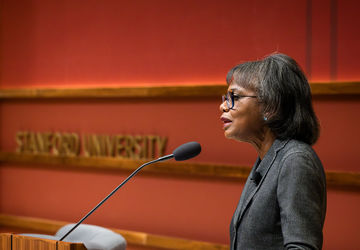Gender stereotypes contribute to misperceptions of gender norms across the world

Take a guess: do most Americans support or oppose affirmative action for women in hiring?
If you guessed that most Americans oppose such a policy, you’re right: most Americans do in fact oppose affirmative action for women in hiring.
If you guessed that most Americans support such a policy, you join the many Americans who overestimated when asked such a question, according to Alessandra Voena, professor of economics, who gave a recent faculty research fellows talk.
Across 60 countries, people are often inaccurate in their perceptions of fellow citizens’ opinions on issues of gender equality, based on a working paper by Voena and co-authors.

“What people perceive to be the public opinion on issues that have to do with gender ends up playing a central role in what outcomes will end up happening,” explains Voena.
“For countries that tend to have less gender equality, this could have to do with a decision as essential as whether a woman should be free to work outside the home. But when we move to countries where women have more formal legal rights, there’s still substantial gaps; for example, we see fewer women in business or leadership positions in the United States or Norway.”
Voena’s analysis is based on Gallup World Poll 2020, which polled nationally representative samples of adults in 60 countries totalling more than 66,000 people, across a wide range of continents and economic profiles. People answered a variety of questions, including a set of questions from Voena and her colleagues, asking first whether they personally support either women’s freedom to work outside the home or affirmative action for women in hiring, and then to estimate both how many men and how many women in their country would support that same issue.
When it comes to people’s actual beliefs, Voena found widespread support for women’s right to work outside the home across all 60 countries. However, support for affirmative action for women in hiring varied, with people in the Global South supporting affirmative action for women, and people in the Global North opposing affirmative action for women.
“The countries where women tend to do better in terms of economic outcomes are the ones that support affirmative action the least,” said Voena. People who saw sexism as an issue in their country tended to support affirmative action for women more, and women tended to support both issues slightly more than men.
But what do people think other people in their country believe about these issues? Perceptions of such social norms can shape people’s beliefs of what is acceptable for women in ways that can contribute to gender inequality.

For example, a previous study led by a different group of economists found that young married men in Saudi Arabia often privately supported women’s right to work outside the home, but incorrectly believed that most men like them opposed such a right. By informing them that their support was actually the majority view, economists were able to change men’s behaviors, causing men to be more willing to support their wives when their wives looked for jobs.
Such misperceptions of social norms are not limited to Saudi Arabia, according to Voena.
“Support for basic rights, meant as women's freedom to work outside the home, tends to be universally underestimated,” noted Voena. Women’s right to work outside the home in fact received widespread support across all 60 countries.
As for affirmative action for women in hiring, people’s misperceptions varied across countries. In the Global North, people overestimated support for affirmative action for women in hiring, which in fact, most people opposed. In the Global South, Voena found the opposite pattern: people underestimated support for affirmative action for women in hiring, which in fact, most people supported.
What might explain these patterns of over and underestimation? Voena found that overestimates of support for affirmative action in the Global North were explained by people overestimating women’s support in particular. People in the Global North expected women in their country to be strongly in favor, whereas in fact, women in their country tended to be split or even oppose affirmative action for women.
“It is women in particular who are seen as supportive of affirmative action in countries like the U.S.,” explained Voena, circling the Global North on a plot of misperceptions in each country. “In fact, women do support it more than men, but they don’t support it more than men by 20 percentage points.”
Likewise, the underestimates in the Global South were explained by people underestimating men’s support. People in the Global South expected men in their country to be strongly opposed, whereas in fact, men were only slightly opposed.
According to Voena, such patterns in misperception can be explained by two forces.
“Everywhere, the view of the minority seems to be exaggerated. The smaller the minority, the greater the exaggeration,” explained Voena. People could exaggerate the minority opinion in their country for a variety of reasons, such as a tendency to make estimates towards the middle of the scale, or disproportionate media coverage of a loud minority.
“But you need one more ingredient to explain the thinking: the notion of stereotyping, that is, the idea of the exaggeration of differences between men and women's views,” notes Voena. People expect women and men to hold vastly different opinions on these issues, whereas the true gender differences in opinions are relatively modest. “Men’s and women's views are less different than people seem to perceive them,” concludes Voena.
Widespread misperceptions of social norms can illuminate why progress toward gender equality has slowed. Correcting people’s perceptions of social norms may be a way to accelerate progress on gender equality across countries.


